Keywords
Food service, hospital, evaluation, personnel, HACCP
Introduction
Meals offered to patients inside the hospital environment are a part of their overall care for recovery. Obviously, this food should be safe and of good quality. However, there are many recorded cases of food-borne infections in hospitals. Such cases may lead to serious diseases, expensive treatments for their cure, contamination to other patients, and services disorganisation [1]. Moreover, the consequences of food borne infections can range from annoying to life-threatening for a patient, since they can lead up to death in vulnerable groups [2-4]. In the context of the overall effort to improve quality of hospital food services, nutrition has been of particular interest. One of the reasons is that the patient perception of the served meals is directly related with their satisfaction of the overall hospital services [5]. Furthermore, if we take into consideration that a large percentage of the meals served in the ward are not consumed –with obvious financial consequences– it is evident that the food offered should be desirable by the consumers. In order for this to be achieved, food quality factors or factors regarding the performance and behaviour of the personnel involved in food services should be estimated. However, the most important reason why hospitals should be very careful in food services is the direct relation of a good nutritional status with the overall healing course of the patient. A bad nutritional status combined with the severity of the disease can increase hospitalization time or even morbidity [6]. According to a meta-analysis, the increase of food intake decreases the rate of complications, mortality and hospitalization time [7]. Reduced food intake, which may result to macro- and micro-nutrient deficiency, may have functional, metabolic and psychological consequences. Those include risk for postoperative complications, muscle tissue loss, delayed wound healing, structure alterations in the small intestine that may lead to dis-absorption, mood collapse and an overall sense of weakness and appetite loss [8].
The systems of production and distribution of meals can have a significant impact on the food intake of hospital patients who are likely to develop malnutrition [9,10]. In a research conducted among 2347 patients in Queensland Australia, a strong relation of patient satisfaction with the catering services on factors such as taste, variety, temperature and personnel was determined, regardless the system used by each hospital [11]. There isn’t any constant relation between patient satisfaction and various meal distribution systems [12]. On the other hand, there were studies connecting patient satisfaction with the system applied. For example, in a research conducted within a big university hospital of United Kingdom (UK), discovered that generally the patients were more pleased with the steamplicity system [13]. In another study conducted in England, it was shown that patient satisfaction is amplified by the ability to choose at the point of consumption, provided by the bulk trolley system. It also depends on the temperature and structure of the meals, which are better in the radial system [14]. Patient satisfaction however, seems to be enhanced by the service of snacks between meals, in serving hours other than those of the standard meals [15].
Aim
The aim of the present study was the assessment of the patient satisfaction from food services in the Greek hospitals.
Methods
Eleven hospitals were chosen to participate, of which the sample derived from adult hospitalized patients. Data was collected through personal interview upon questionnaires.
The questionnaires prepared for this study include 14 questions, simply phrased in order to be comprehended by the patients. All questions except of one were closed type and only one was of open type. Most of them comprise of a verbal or numeral scale, such as Likert type scale. Question number 14 was of an open type in order to records patient suggestions for the improvement of their satisfaction. In the appendix, the layout of the questionnaire is presented.
Prior the interviews the general manager was contacted in order to acquire approval for this research.The interviews were performed after the receipt of the signed letter of approval by the general manager.The patients were orally inquired if they consent for the interview.
For the assessment of the patient satisfaction of the hospital food services, eleven hospitals from the Attica area were chosen to participate to this study (Agios Savvas, Aretaieio, Sismanogleio, Tzaneio, Metaxa, Asklipieio Voulas, Laiko, Erythros Stavros, A. Siggros, G. Genimatas, Elpis). The sample derived from 637 adult patients who were hospitalized in the above mentioned hospitals, from September 2009 until April 2010. Sample collection was randomized from the following clinics: ophthalmology, neurosurgery, cardiology, urology, gynecology, general medicine, pathology, endocrinology, rheumatology, orthopedics, vascular surgery, gastroenterology, plastic surgery, maxillary surgery, oncology, and pneumonology. The patients should be at least two to three days hospitalized. The questionnaires were used for personal interviews with the help of a team of undergraduate students from Harokopio University and from Athens Technical Education Institute.
The anonymity of the volunteers was ensured through encoding of the questionnaires. The data was analysed with statistical program PASW 18.0 for Windows (SPSS Inc. 2009).
Results
As seen in Table 1 the patient participation per hospital ranged from 7 to 27 % with an average of 12%. 52% of the participant patients were men and 48% were women. There was not any statistical significant difference in relation to sex and the finding of a foreign object in the tray, or the finding of expired food.The mean age of the patients that filled the questionnaires, was 61 years (+/-16.3). In the question regarding the overall food assessment the mean score was 7.5 on a 10 grade scale, in the question regarding the personnel behaviour the mean score was 9.2 and in the question regarding the hygiene conditions while serving and during collecting the tray, the mean score was 9.1For the question regarding the meals that patients like most, 89.5% said traditional Greek pastitsio and 87.3% oven baked potatoes (Table 2). Regarding food ordered from outside, 34% replied “quite rarely” while only 5.7% said “often” (Table 3).
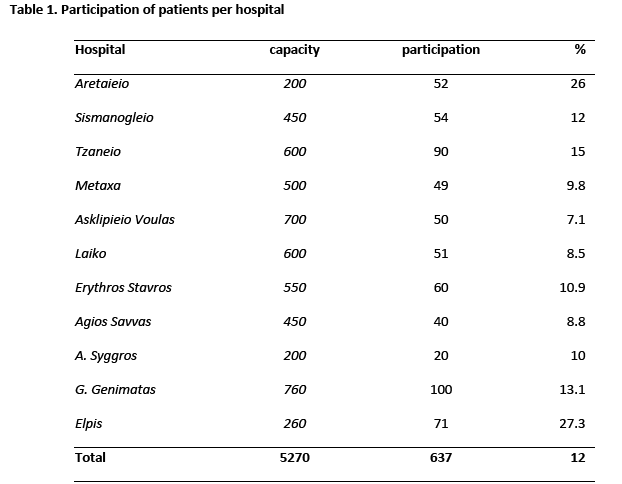
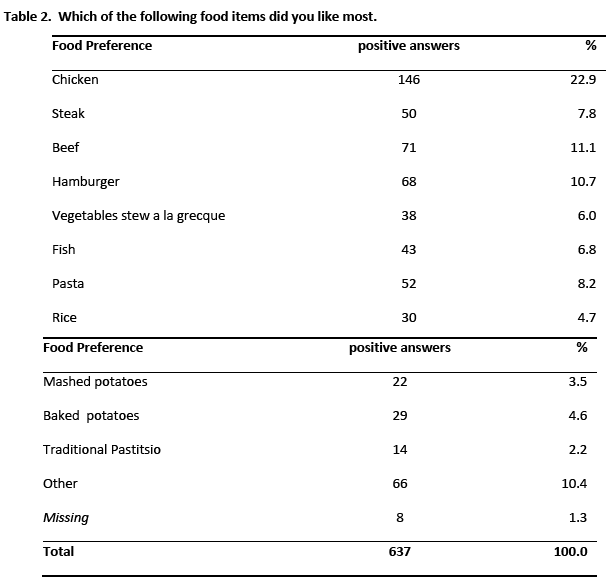
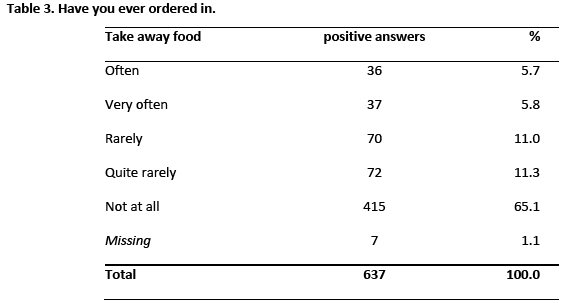
As seen in Table 4, in the question “During your stay in the hospital were you given any expired food and if yes, what was that?”; 99.4% answered negatively, while in the question “Did you notice during your stay in the hospital the presence of a foreign object (insect, metal/ plastic item, etc) in the serving tray or in the food and if yes which kind?”; 98.4% replied no.
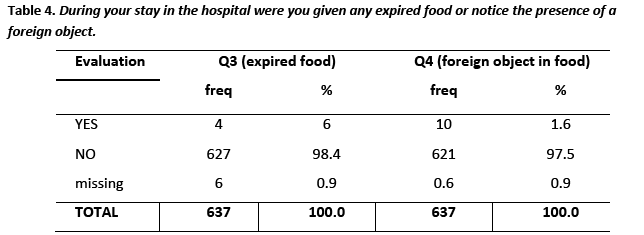
As seen in Table 5, in question 5, regarding the temperature of the hot plates, a percentage of 89.5% said that the plates were tepid and in question 6, regarding the temperature of the cold plates, 79.1% of the respondents said that the plates were handed out cold.
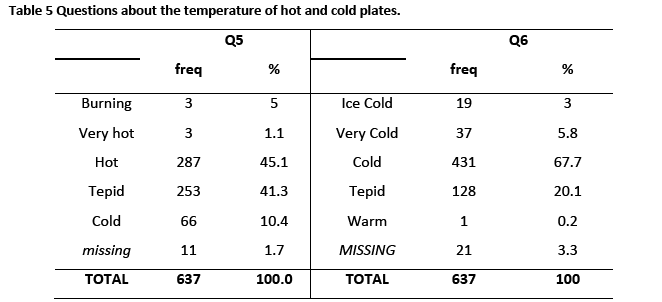
As seen in Table 6, regarding the image of the served food, a percentage of 97% said that it was mediocre.
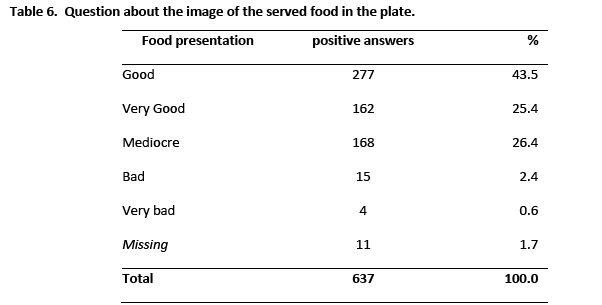
As seen in Table 7, 86.3% finds tastiness to be mediocre while 88.2% things that in a mediocre way, food helps in the faster recovery. Finally, 97.3% of the patients think that the food is not prepared according to hygiene rules and regulations.
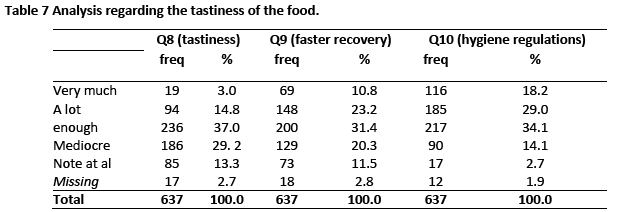
As seen in Table 8, regarding patients’ suggestions for the improvement of food or catering in the hospital, 89.9% of the sample suggested more meals, while in a percentage 90.8% suggested the use of gloves during serving. A percentage of 91.6% of the sample made a suggestion for pre-packed spoons for the soup and the canned fruits in syrup. Finally, 41.2% suggested tastier food and 78.2% bigger portions.
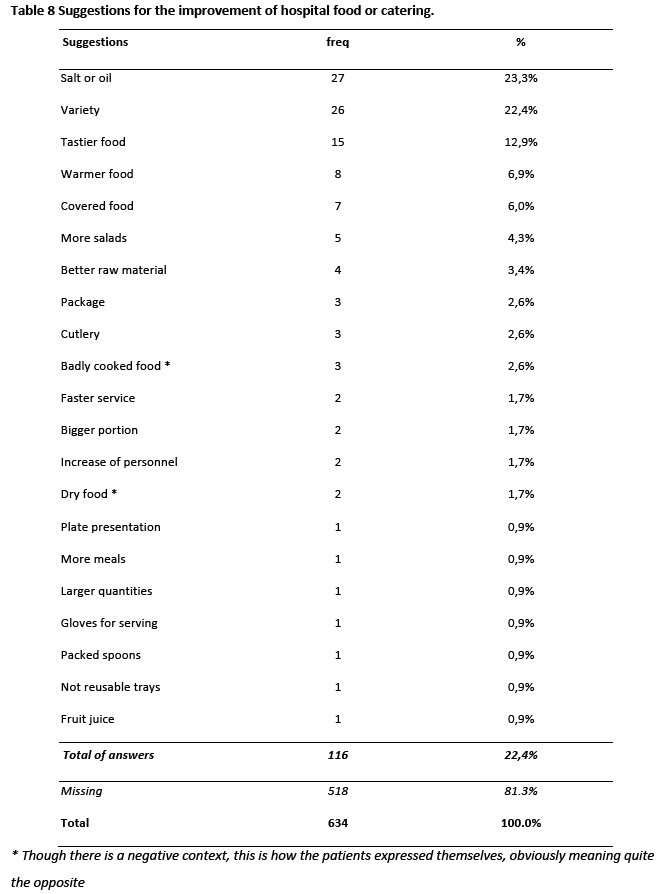
The statistical analysis regarding sex and food consumption inside the hospital shows that men in comparison to women order from outside more often in a percent of 3.3% and a level of significance p<0.05.
Discussion
The aim of the present research was to study and evaluate the factors that influence patient satisfaction in regards to their meals during their hospitalization. This study also investigated the perception of hygiene during serving of the meals and furthermore the personnel’s behaviour during serving.
The results indicate that overall in Greek hospitals the basic hygiene in regards to serving food is implemented, as deemed by the Committee of Hospital Infections or by the Public Health Inspector in the hospital. In a study that was contacted to seven hospitals of Missouri USA it was discovered that the clinical dietician and the personnel involved in the catering services, have different perspectives in regards to implementing the Total Quality Management [16]. It is obvious that the education, cooperation and communication of the personnel are essential elements for the food service department of the hospitals.
In regards to the meals temperature, most of the cold plates are served tepid, while 79.1% of the cold plates are served cold. This find is supported from other research as well, such as a research held in England, where the patients’ satisfaction was increased by the possibility to choose at the consumption site, given by the bulk trolley system [14]. Furthermore, it depends on the temperature and the structure of the meals which are better in the satellite serving system. However patients’ satisfaction seems to increase by the serving of intermediate snacks, in times other than those of the scheduled meals [15].
The image of the served food was judged to be mediocre by the majority of the patients. In a percentage of 86.3%, the patients think that the food tastiness is mediocre, while 88.2% think that the food in a mediocre level helps in the faster patients’ recovery. Furthermore, most of the patients think that the food is prepared according to hygiene rules in a mediocre way.
Regarding the patient’s suggestions for the meals or nutrition improvement in the hospital, almost the majority of the sample suggested more meals and the use of gloves during serving. The majority of the patients suggested disposable spoons for the consumption of soup and canned fruit. Increased food taste was the suggestion of 41.2% and 78.2% proposed the serving of larger portions.
It should be noted that quantity, safety and organoleptic characteristics of the food are included in the qualitative characteristics of a meal. According to a research that took place in four institutions of NHS, the strongest marker of patients’ satisfaction of the hospital meals, is the food quality [17]. The outputs of the study in a private hospital of Australia are in accordance to the above mentioned [5]. In this study, food quality gathered 60% of the patients’ negative comments. Those comments were in regard to the portion size, the meat texture and the way the vegetables were cooked. Taste, image and temperature seem to play an important role as well [18]. This could be true for an adequate variety of foods in the menu, so that the patient can have a number of choices [19].
The method of this study has certain limitations. The answers to the questions are subjective and cannot be verified with audits or sampling. The emotionally stressed patients are not used at taking part in such kind of surveys and environmental sources play a role in overall patient satisfaction with an in-bed hospitalization [20]. However the proposed questionnaire has simple questions that require straightforward answers and can be used for further research.
Conclusions
The results of this study indicate that the majority of the patients seem to be pleased from the quality and the variety of the meals; they judged positively the behaviour of the food service personnel and the hygiene of serving conditions. Nevertheless, factors like temperature and hygiene conditions for the meal that reaches the patient are not always perceived to be in such a way to fulfil the necessary prerequisite requirements. In a small amount of the questionnaires there were reports and suggestions for changes in the serving of meals and in the personnel’s behaviour.
In conclusion, a re-evaluation of the patient satisfaction in a larger sample of patients in the near future could be necessary, for comparison purposes. Finally, the results indicate the importance of total quality management systems as a driver for better patient satisfaction.
2649
References
- Lund B, O’Brien S. Microbiological safety of food in hospitals and other healthcare settings. J Hosp Infect 2009; 73: 109-120.
- Joseph CA, Palmer SR. Outbreaks of Salmonella infection in hospitals in England and Wales 1978-1987. Br Med J 1989; 298: 1161-1164.
- Wall PG, Ryan MJ, Ward LR, Rowe B. Outbreaks of salmonellosis in hospitals in England and Wales: 1992-1994. J Hosp Infect 1996; 33(3): 181-190.
- Meakins SM, Adak GK, Lopman BA, O’Brien SJ. General outbreaks of infectious intestinal disease (IID) in hospitals, England and Wales, 1992-2000. J Hosp Infect 2003; 53(1): 1-5.
- Fallon A, Gurr S, Hannan-Jones M, Bauer J. Use of the acute care hospital foodservice patient satisfaction questionnaire to monitor trends in patient satisfaction with foodservice at an acute care private hospital. Nutr Diet 2008; 65(1): 41–6.
- ESPEN. Education and Clinical Practice Committee. ESPEN guidelines for nutrition screening. Clin Nutr 2003; 22(4): 415-421.
- Stratton RJ, Green CJ, Elia M. Disease-related malnutrition: an evidence-based approach to treatment. Wallingford: CAB International; 2003.
- Schenker S. Undernutrition in the UK. British Nutrition Foundation. Nutr Bull 2003; 28: 87-120.
- Mcwhirter JP, Pennington CR. Incidence and recognition of malnutrition in hospital. Br Med J 1994; 308: 945-948.
- Mowe M, Bosaeus I, Rasmussen HH, Kondrup J, Unosson M, Irtun O. Nutritional routines and attitudes among doctors and nurses in Scandinavia: a questionnaire based survey. Clin Nutr 2006; 25(3): 524-532.
- Wright O, Connely, L, Capra S. Consumer evaluation of hospital foodservice quality: an empirical investigation. Int J Health Care Qual Assur 2006; 19(2):181-194.
- Lambert LG, Boudreaux L, Conklin MT, Yadrick K. Are new meal distribution systems worth the effort for improving patient satisfaction with foodservice? J Am Diet Assoc 1999; 99: 1112-4.
- Edwards JSA, Hartwell HJ. Hospital food service: a comparative analysis of systems and introducing the ‘Steamplicity’ concept, J Hum Nutr Diet 2006; 19(6): 421-430.
- Hartwell HJ, Edwards J and Beavis J. Plate versus bulk trolley food service in a hospital: comparison of patients’ satisfaction. Nutrition 2007; 23(3): 211-218.
- White M, Wilcox J, Watson R, Rogany A, Meehan L. Introduction of a patient-centred snack delivery system in a children’s hospital increases patient satisfaction and decreases foodservice costs, J Foodserv 2008; 19:194-199.
- Chong Y, Unklesbay N, Dowdy R. Clinical Nutrition and Foodservice Personnel in Teaching Hospitals have Different Perceptions of Total Quality Management Performance, J Am Diet Assoc2000; 100(6): 1044-1049.
- Hwang LJ, Eves A, Desombre T. Gap analysis of patient meal service perceptions. Int J Health Care Qual Assur 2003; 16(3):143-153.
- Watters C, Sorensen J, Fiala A, Wismer W. Exploring patient satisfaction with foodservice through focus groups and meal rounds. J Am Diet Assoc 2003; 103(10):1347-1349.
- Porter J and Cant R. Exploring hospital patients’ satisfaction with cook-chill foodservice systems: a preliminary study using a validated questionnaire. J Foodserv. 2009; 20(2):81-89.
- Harris, PB, McBride G, Ross C, Curtis L. A place to heal: Environmental sources of satisfaction among hospital patients. J Appl Soc Psych 2002;32, 1276–1299.













